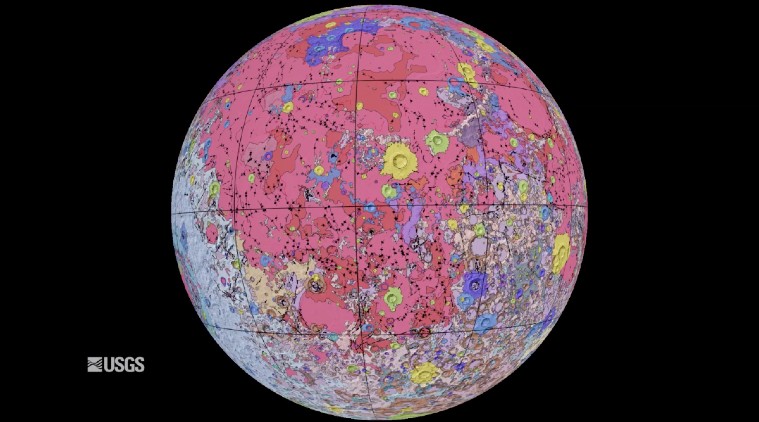- India
- International
NASA, USGS release detailed geological map of the moon
The new map showcases the Moon in a 1:50,00,000-scale size, and is being claimed to come handy to researchers, scientists, students and the general public.
 The organisation claims that it will come handy to understand the surface of the Moon. It adds that the map will also help researchers learn the history behind the formations located on the Moon’s surface. (Image: USGS)
The organisation claims that it will come handy to understand the surface of the Moon. It adds that the map will also help researchers learn the history behind the formations located on the Moon’s surface. (Image: USGS)
United States Geological Survey (USGS) in partnership with NASA and the Lunar Planetary Institute has released a new comprehensive map of the Moon, called the ‘Unified Geologic Map of the Moon’. It states that this new map will serve as the “definitive blueprint of the Moon’s surface geology for future human missions.”
The new map showcases the Moon in a 1:50,00,000-scale size, and is being claimed to come handy to researchers, scientists, students and the general public. It will come handy to NASA very soon, considering that it is planning to send astronauts once again to the moon after a long time, by 2024.
The Unified Geologic Map of the Moon is currently available on USGS’s official website. The organisation claims that it will come handy to understand the surface of the Moon. It adds that the map will also help researchers learn the history behind the formations located on the Moon’s surface.
The map has been created with the help of the information gathered from six Apollo-era regional maps. That’s not it, it also uses data from recently held satellite missions to the Moon. Thus providing the public with the most updated and accurate map of the Moon available of now.
Explained: What was Apollo 13’s mission to the Moon, what went wrong?

USGS used all of the data sets acquired by them to draw up the final map. Apart from this, the organisation also unified the description of the rock layers, to bring consistency to the names and ages of the rocks.
The USGS website is also hosting a public domain video, showcasing a rotating globe of the new Unified Geologic Map of the Moon. The shaded topography seen has been made with the help of the Lunar Orbiter Laser Altimeter (LOLA).
Also Read: Missed the Super Pink Moon? Here’s a list of all upcoming lunar events in 2020
The near side of the Moon, which is the most explored side can be seen full of pink colours that show the Imbrian era formation. This formation according to the USGS took place around 3.5 billion years ago, when the Moon’s surface was hit by many asteroids, causing irregular formations.
Corey Fortezzo, a geologist at USGS and the lead author behind the study has said that, “this map is a culmination of a decades-long project.” And that “it provides vital information for new scientific studies by connecting the exploration of specific sites on the moon with the rest of the lunar surface.”
More Tech
May 02: Latest News
- 01
- 02
- 03
- 04
- 05




























